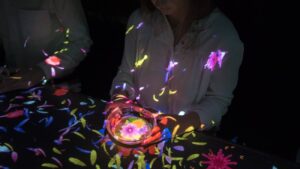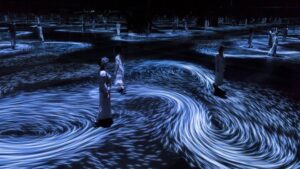If on the one hand the most industrialized societies are characterized by a predominant individualism filtered by the personal pronoun most used, in the technological field, with the various “Iphone“, “Ipad“, “Itunes“, “Icloud“, on the other hand it stands out, surprisingly, the number of visionary artists in the field of digital art and the various technological supports – also followed by specific programs – that make it possible to create dream metaphors and universal symbols of a contemporary collective unconscious. What emerges is a process of digitization of art: on the one hand the creation of visions by and visual digital artists, on the other the creation of websites with navigation of spaces in 3d for a fruition of art immediate and surprising from the PC or smartphone screen such as Kunstmatrix and Artland: platforms characterized by the promotion and sale of contemporary works of art.
It is clear how much this dimension in 3d and the visualizations of high-definition works have developed in recent years and have been used by art lovers – and not only – following the restrictions of the global lockdown caused by the pandemic since last March. Emblematic testimonies are those of various museums around the world, such as the Uffizi Gallery, the Vatican Museums, the MoMa, the Prado Museum, the Hermitage, which have given web users the opportunity to view many works with a virtual tour. But what needs to be monitored most as a contemporary phenomenon is not only the ascertainment of how these spaces are not alternatives to the real but rather continuous: almost projections of real space. But also the observation of being in front of the formation of a first great flow of visions and digital images, which makes us hypothesize that we are facing the most significant artistic and imaginative transformation of this millennium.
In digital art there are precise trends in the use of symbols and visions, as well as a growing number of artists who, through dedicated programs and technologies, create a new artistic phenomenon to be observed and monitored. But this has always happened in the history of art up to a certain point. As Achille Bonito Oliva said many years ago, contemporary art today changes “only itself, its history and its language” while once the avant-gardes “lived the happy utopia of transforming the world through art”. Instead, now we are witnessing a transformation of a part of art – precisely digital art – which in this case changes not only itself but its own use which includes the creation of digital rooms in 3d, navigation on the web. high resolution and the possibility of living incredible experiences in real life with innovative technologies.
In this regard, the set of scenic and sensory modalities of spaces, adequately technologically equipped, such as the first Tokyo Digital Art Museum, inaugurated in June 2018, with spectacular experiences of total immersion in the digital imagery deserve attention. A member of the Team Lab group that created this museum, Takashi Kudo, declared how much they believed in “the possibility of creating digital art with the aim of changing people’s values and contributing to the progress of society”, reiterating their strong interest in the concept of “digital” in the relationship with art.
Furthermore, it is interesting to note – to give an example of the historical processes of art – how digital art shares a sentimental perception of art, a realistic and popular dimension with the imaginary of the Baroque age. But here, clearly, there is no religious propaganda – as was the case in the seventeenth century – but the awareness of conveying, transforming and interpreting the icons of reality in surrealistic, dreamlike, magical, bombastic and, at times, exaggerated atmospheres.
In this direction, we find an all-Italian reality: MEET or the international center for digital culture which, with the support of the Cariplo Foundation, proposes a home for digital culture, in a continuous mix of the arts in the idea of interconnection and participation. Thus a building from the early twentieth century, in Milan, is spread over three floors with a very particular staircase, Living Staircase, which also becomes a space for participation and then the Immersive Room with 15 projectors – which offer bright images in 4k for a projection continues at 270 ° – the Creative Studio for audio and video editing and the Gallery with its exhibition halls characterized by movable and reconfigurable walls. It must also be said that the driving focus of Meet’s digital culture is to connect, link and make the public and users interact with digitalized and participatory innovation processes, promoting a global digital culture. And these are new facts in the world of art. As such, they must be followed to walk in the footsteps of technology where much of our contemporaneity and the history of art of this century pass.
Nilla Zaira D’Urso
Link:
 MORI Building Digital Art Museum. TeamLab Borderless, “Forest of Resonating Lamps”., Interactive Digital Installation, 2016
MORI Building Digital Art Museum. TeamLab Borderless, “Forest of Resonating Lamps”., Interactive Digital Installation, 2016
 MORI Building Digital Art Museum. TeamLab Borderless, “Flowers Bloom in an Infinite Universe inside a Tea Cup”, Interactive Digital Installation, 2016
MORI Building Digital Art Museum. TeamLab Borderless, “Flowers Bloom in an Infinite Universe inside a Tea Cup”, Interactive Digital Installation, 2016
 Meet Fondazione Cariplo “Immersive Room”, 2020
Meet Fondazione Cariplo “Immersive Room”, 2020
 MORI Building Digital Art Museum. TeamLab Borderless “Moving Creates Vortices and Vortices Create Movement”, 2017
MORI Building Digital Art Museum. TeamLab Borderless “Moving Creates Vortices and Vortices Create Movement”, 2017
 Galleria degli Uffizi, tour virtuale della Sala delle Dinastie e della Sala del Cinquecento Veneziano
Galleria degli Uffizi, tour virtuale della Sala delle Dinastie e della Sala del Cinquecento Veneziano

Through art she feels the need to get closer to nature, deciding to create an artistic residence on Etna as a “refuge for contemporary art” for artists and scholars. Thus was born Nake artistic residence. She won the Responsible Etna Award 2015. In 2017, she was invited to the Sala Zuccari, Senate of the Republic, as an art critic. She writes for Italian and foreign artists. Curator of the first Museum of Contemporary Art of Etna and of the “Contemporary Etna” project.






NO COMMENT